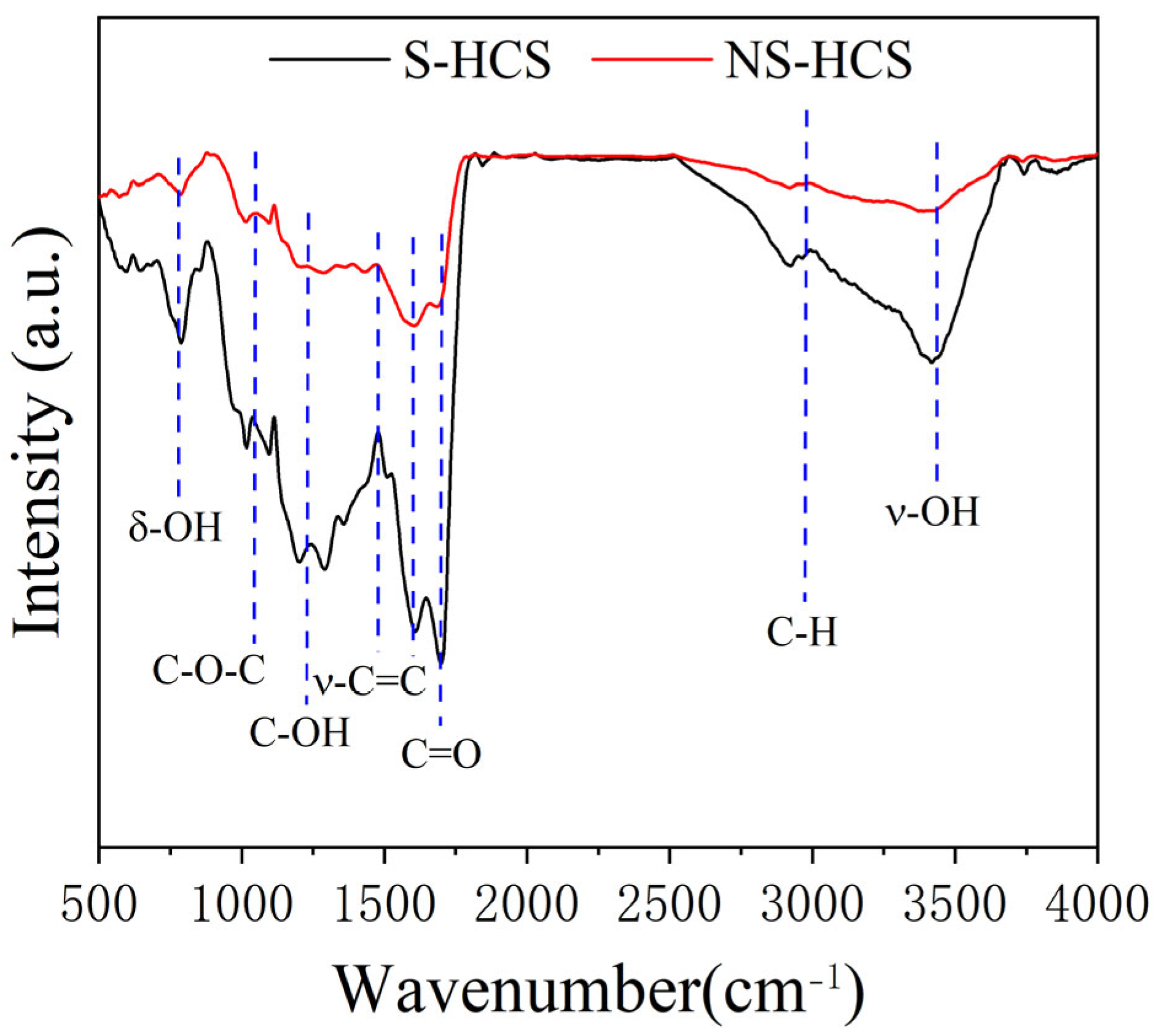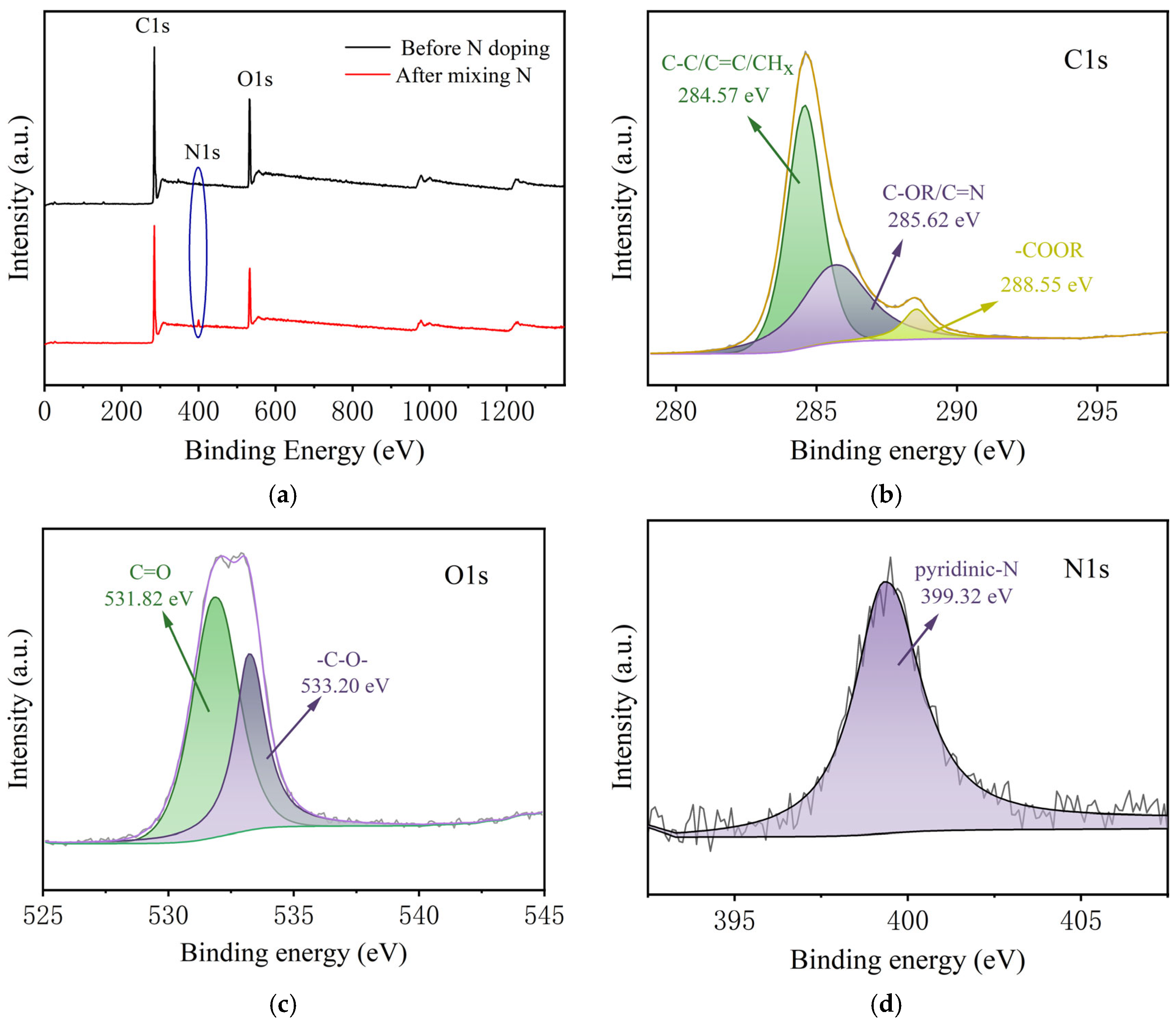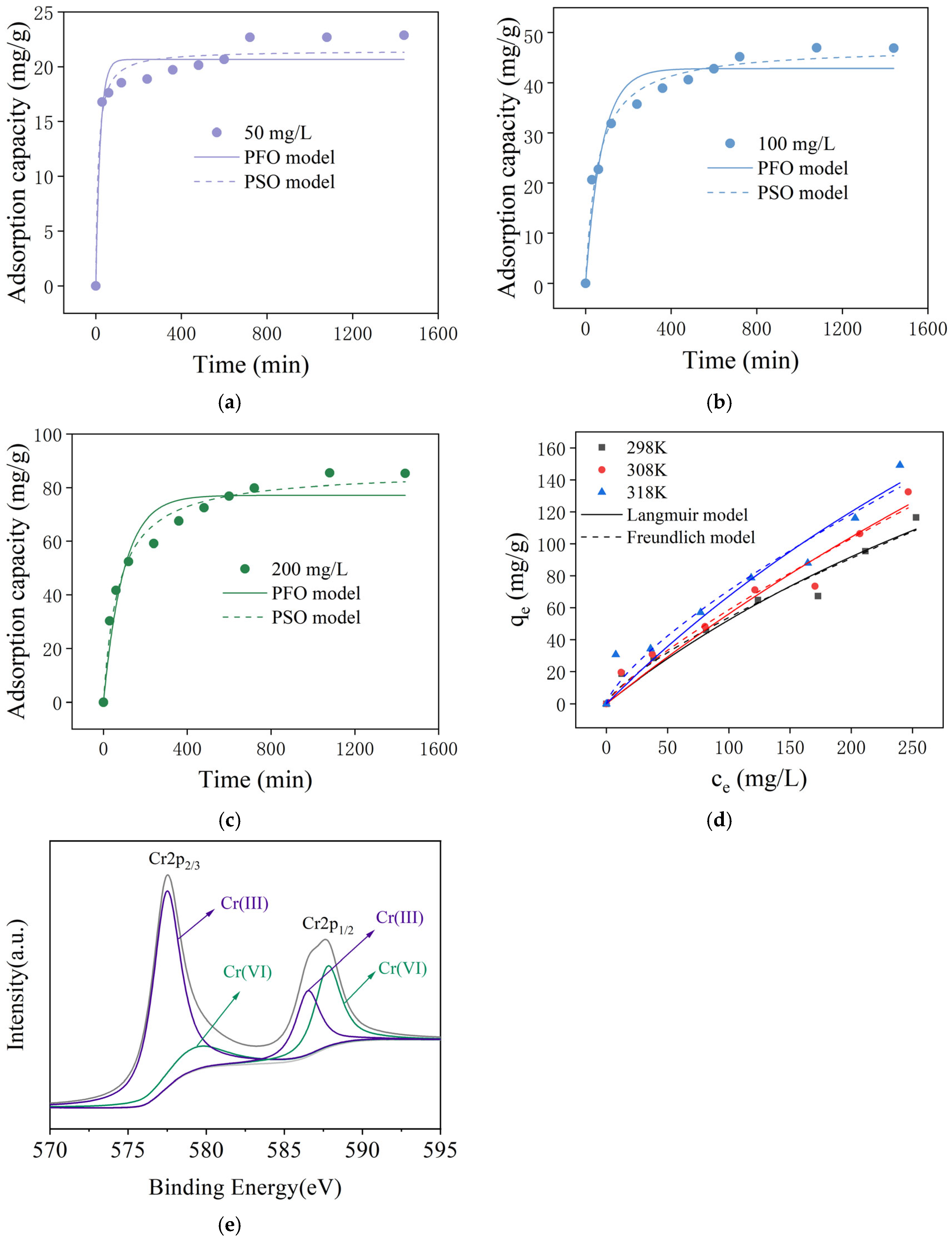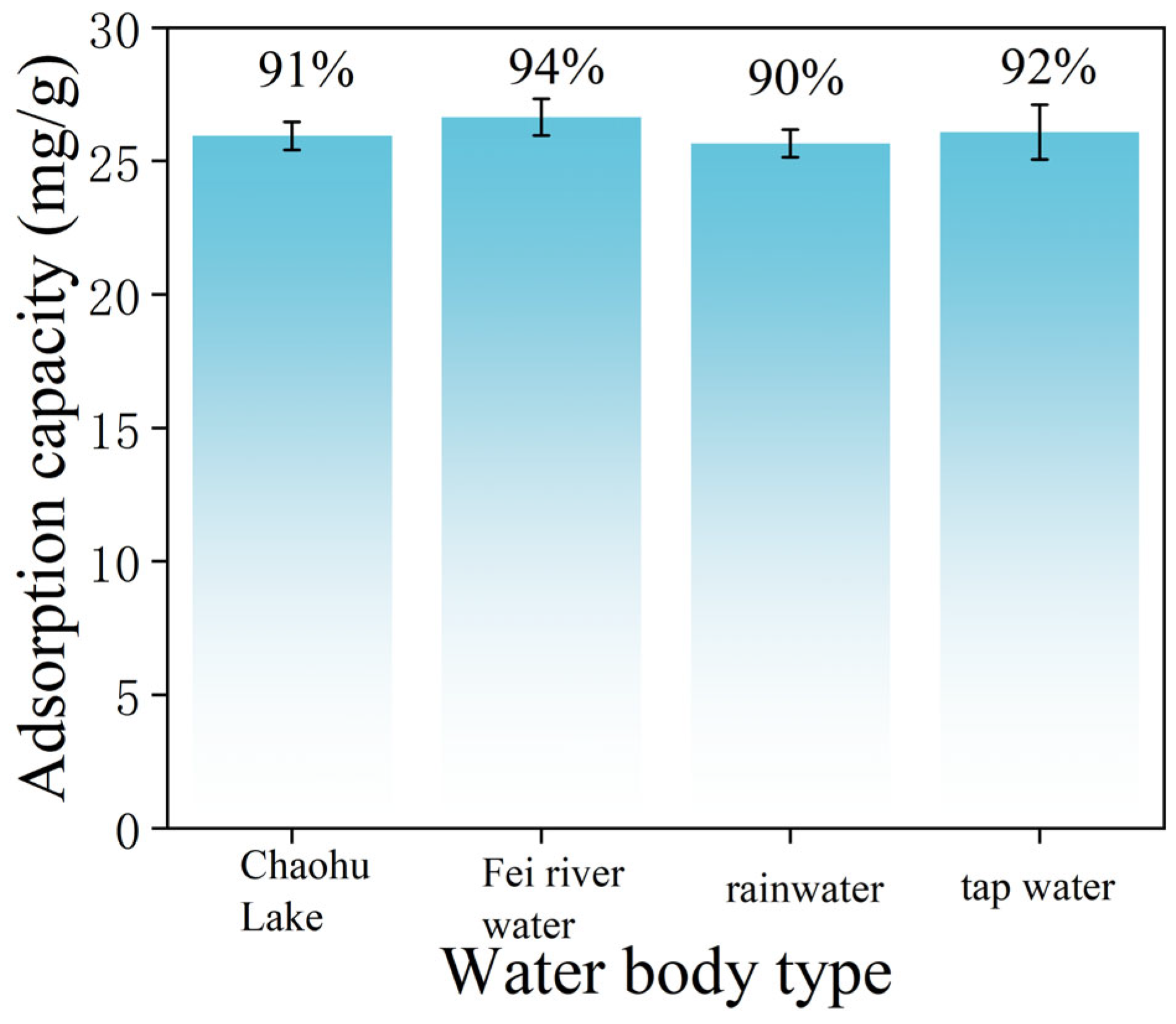Two-Step Hydrothermal Reaction Enhances Removal of Cr(VI) from Wastewater Using Nitrogen-Doped Starch-Based Hydrothermal Carbon
Abstract
1. Introduction
2. Materials and Methods
2.1. Materials
2.2. Synthesis of Starch-Based Two-Step Hydrothermal Carbon
2.3. Characterization of Hydrothermal Carbon
2.4. Adsorption Experiments
2.5. Adsorption Regeneration
3. Results and Discussion
3.1. Microstructure and Elemental Distribution
3.1.1. Surface Morphology
3.1.2. Elemental Composition and Chemical Structure
3.2. Effects of Environmental Conditions on Cr(VI) Adsorption by NS-HCS
3.3. Kinetic Models
3.4. Isotherms and Thermodynamics
3.5. Ion Competition and Regeneration
3.6. Actual Water Treatment Experiment
4. Conclusions
Supplementary Materials
Author Contributions
Funding
Institutional Review Board Statement
Informed Consent Statement
Data Availability Statement
Acknowledgments
Conflicts of Interest
Abbreviations
| NS-HCS | Nitrogen-doped starch-based hydrothermal carbon |
| SHCS | Starch-based hydrothermal carbon |
References
- Xie, S. Water contamination due to hexavalent chromium and its health impacts: Exploring green technology for Cr (VI) remediation. Green Chem. Lett. Rev. 2024, 17, 2356614. [Google Scholar] [CrossRef]
- He, G.; Xiao, Y.; Du, H. An overview and recent progress in photocatalytic Cr (Ⅵ) reduction and hydrogen evolution. Int. J. Hydrogen Energy 2024, 53, 633–646. [Google Scholar] [CrossRef]
- Fan, X.; Xin, R.; Li, L.; Zhang, B.; Li, C.; Zhou, X.; Chen, H.; Zhang, H.; OuYang, F.; Zhou, Y. Progress in the preparation and physical properties of two-dimensional Cr-based chalcogenide materials and heterojunctions. Front. Phys. 2024, 19, 23401. [Google Scholar] [CrossRef]
- Huang, H.; Gao, Y.-J.; Cao, Z.-X.; Tian, Z.-Q.; Bai, Y.-F.; Tang, Z.-X.; Ali, A.; Zhao, F.-J.; Wang, P. Ecotoxicity of hexavalent chromium [Cr (VI)] in soil presents predominate threats to agricultural production with the increase of soil Cr contamination. J. Hazard. Mater. 2024, 476, 135091. [Google Scholar] [CrossRef]
- Koc, I.; Cobanoglu, H.; Canturk, U.; Key, K.; Kulac, S.; Sevik, H. Change of Cr concentration from past to present in areas with elevated air pollution. Int. J. Environ. Sci. Technol. 2024, 21, 2059–2070. [Google Scholar] [CrossRef]
- Min, X.; Zhang, K.; Chen, J.; Chai, L.; Lin, Z.; Zou, L.; Liu, W.; Ding, C.; Shi, Y. Bacteria-driven copper redox reaction coupled electron transfer from Cr (VI) to Cr (III): A new and alternate mechanism of Cr (VI) bioreduction. J. Hazard. Mater. 2024, 461, 132485. [Google Scholar] [CrossRef]
- Keshta, B.E.; Yu, H.; Wang, L.; Gemeay, A.H. Cutting-edge in the green synthesis of MIL-101 (Cr) MOF based on organic and inorganic waste recycling with extraordinary removal for anionic dye. Sep. Purif. Technol. 2024, 332, 125744. [Google Scholar] [CrossRef]
- Cheng, S.; Zeng, X.; Liu, P. One-step synthesis of magnetic N-doped carbon nanotubes derived from waste plastics for effective Cr (Ⅵ) removal. Arab. J. Chem. 2024, 17, 105956. [Google Scholar] [CrossRef]
- Verma, B.; Balomajumder, C. Magnetic magnesium ferrite–doped multi-walled carbon nanotubes: An advanced treatment of chromium-containing wastewater. Environ. Sci. Pollut. Res. 2020, 27, 13844–13854. [Google Scholar] [CrossRef]
- Zhong, G.; Huang, J.; Yao, Z.; Luo, B.; Li, K.; Xu, S.; Fu, X.; Cao, Y. Intrinsic acid resistance and high removal performance from the incorporation of nickel nanoparticles into nitrogen doped tubular carbons for environmental remediation. J. Colloid Interface Sci. 2020, 566, 46–59. [Google Scholar] [CrossRef]
- Song, Z.; Xu, Y.; Zhang, M.; Zhu, W.; Yang, X.; Hao, D.; Li, Q. Efficient removal of Cr (VI) by Bifunction zinc porphyrin COF: Coupling adsorption with Photocatalysis, performance Evaluation, and mechanism analysis. J. Colloid Interface Sci. 2025, 677, 346–358. [Google Scholar] [CrossRef] [PubMed]
- Wang, C.; You, C.; Rong, K.; Shen, C.; Yang, F.; Li, S. An S-scheme MIL-101 (Fe)-on-BiOCl heterostructure with oxygen vacancies for boosting photocatalytic removal of Cr (VI). Acta Phys.-Chim. Sin. 2024, 40, 2307045. [Google Scholar] [CrossRef]
- Fan, Y.; Olsson, E.; Johannessen, B.; D’angelo, A.M.; Thomsen, L.; Cowie, B.; Smillie, L.; Liang, G.; Lei, Y.; Bo, G.; et al. Manipulation of transition metal migration via cr-doping for better-performance li-rich, co-free cathodes. ACS Energy Lett. 2024, 9, 487–496. [Google Scholar] [CrossRef]
- Bogireddy, N.K.R.; Rios, S.E.S.; Agarwal, V. Simple one step synthesis of dual-emissive heteroatom doped carbon dots for acetone sensing in commercial products and Cr (VI) reduction. Chem. Eng. J. 2021, 414, 128830. [Google Scholar] [CrossRef]
- Qin, X.; Tao, R.; Cheng, S.; Xing, B.; Meng, W.; Nie, Y.; Zhang, C.; Yu, J. Microwave-assisted one-pot method preparation of ZnO decorated biochar for levofloxacin and Cr (Ⅵ) removal from wastewater. Ind. Crops Prod. 2024, 208, 117863. [Google Scholar] [CrossRef]
- Yazid, H.; Bouzid, T.; El Mouchtari, E.M.; Bahsis, L.; El Himri, M.; Rafqah, S.; El haddad, M. Insights into the adsorption of Cr (VI) on activated carbon prepared from walnut shells: Combining response surface methodology with computational calculation. Clean Technol. 2024, 6, 199–220. [Google Scholar] [CrossRef]
- Chen, Y.; Qian, Y.; Ma, J.; Mao, M.; Qian, L.; An, D. New insights into the cooperative adsorption behavior of Cr (VI) and humic acid in water by powdered activated carbon. Sci. Total Environ. 2022, 817, 153081. [Google Scholar] [CrossRef]
- Du, H.; Yuan, D.; Li, W.; Wang, L.; Li, Y.; Che, L.; Tian, W.; Salama, E.; Ossman, M.; Lin, F. Efficient removal of toxic organics and reduction of Cr (VI) to Cr (III) from tannery sludge: A comparative study of microwave pyrolysis and conventional pyrolysis. Sep. Purif. Technol. 2025, 354, 128736. [Google Scholar] [CrossRef]
- Li, S.; Dong, K.; Cai, M.; Li, X.; Chen, X. A plasmonic S-scheme Au/MIL-101 (Fe)/BiOBr photocatalyst for efficient synchronous decontamination of Cr (VI) and norfloxacin antibiotic. EScience 2024, 4, 100208. [Google Scholar] [CrossRef]
- Sujatha, S.; Sivarethinamohan, R. A critical review of Cr (VI) ion effect on mankind and its amputation through adsorption by activated carbon. Mater. Today Proc. 2021, 37, 1158–1162. [Google Scholar] [CrossRef]
- Jawed, A.; Golder, A.K.; Pandey, L.M. Bio-based iron oxide nanoparticles forming bi-functional chitosan composite adsorbent for Cr (VI) decontamination. Chem. Eng. J. 2024, 481, 148411. [Google Scholar] [CrossRef]
- Liang, H.; Zhang, H.; Zhao, P.; Zhao, X.; Sun, H.; Geng, Z.; She, D. Synthesis of a novel three-dimensional porous carbon material and its highly selective Cr (VI) removal in wastewater. J. Clean. Prod. 2021, 306, 127204. [Google Scholar] [CrossRef]
- Cao, D.; Guan, J.; Du, J.; Sun, Q.; Ma, J.; Li, J.; Liu, J.; Sheng, G. Halogen-functionalized covalent organic frameworks for photocatalytic Cr (VI) reduction under visible light. J. Hazard. Mater. 2024, 476, 134956. [Google Scholar] [CrossRef]
- Hasija, V.; Raizada, P.; Singh, P.; Verma, N.; Khan, A.A.P.; Singh, A.; Selvasembian, R.; Kim, S.Y.; Hussain, C.M.; Nguyen, V.-H.; et al. Progress on the photocatalytic reduction of hexavalent Cr (VI) using engineered graphitic carbon nitride. Process Saf. Environ. Prot. 2021, 152, 663–678. [Google Scholar] [CrossRef]
- Wang, K.; Zeng, S.; Li, G.; Dong, Y.; Wang, Q.; Zhang, L.; Ren, Z.; Wang, P. Superoxide radical induced redox processes for simultaneous reduction of Cr (VI) and oxidation of ciprofloxacin in wastewater. Appl. Catal. B Environ. 2024, 343, 123565. [Google Scholar] [CrossRef]
- Li, K.; Xu, W.; Song, H.; Bi, F.; Li, Y.; Jiang, Z.; Tao, Y.; Qu, J.; Zhang, Y. Superior reduction and immobilization of Cr (VI) in soil utilizing sulfide nanoscale zero-valent iron supported by phosphoric acid-modified biochar: Efficiency and mechanism investigation. Sci. Total Environ. 2024, 907, 168133. [Google Scholar] [CrossRef]
- Song, J.; Meng, Z.; Wang, X.; Zhang, G.; Bi, C.; Hou, J. One-step microwave method synthesis of Fe3O4 nanoribbon@ carbon composite for Cr (Ⅵ) removal. Sep. Purif. Technol. 2022, 298, 121530. [Google Scholar] [CrossRef]
- Mazkad, D.; El Idrissi, A.; Marrane, S.E.; Lazar, N.E.; El Ouardi, M.; Dardari, O.; Channab, B.E.; Ait Layachi, O.; Farsad, S.; Baqais, A.; et al. An innovative diatomite-polypyrrole composite for highly efficient Cr (VI) removal through optimized adsorption via surface response methodology. Colloids Surf. A Physicochem. Eng. Asp. 2024, 685, 133172. [Google Scholar] [CrossRef]
- Asimakopoulos, G.; Baikousi, M.; Salmas, C.; Bourlinos, A.B.; Zboril, R.; Karakassides, M.A. Advanced Cr (VI) sorption properties of activated carbon produced via pyrolysis of the “Posidonia oceanica” seagrass. J. Hazard. Mater. 2021, 405, 124274. [Google Scholar] [CrossRef]
- Juturu, R.; Murty, V.R.; Selvaraj, R. Efficient adsorption of Cr (VI) onto hematite nanoparticles: ANN, ANFIS modelling, isotherm, kinetic, thermodynamic studies and mechanistic insights. Chemosphere 2024, 349, 140731. [Google Scholar] [CrossRef]
- Poudel, M.B.; Awasthi, G.P.; Kim, H.J. Novel insight into the adsorption of Cr (VI) and Pb (II) ions by MOF derived Co-Al layered double hydroxide@ hematite nanorods on 3D porous carbon nanofiber network. Chem. Eng. J. 2021, 417, 129312. [Google Scholar] [CrossRef]
- Wang, M.; Chen, Y.; Zhang, Y.; Wei, S.; Zhao, X.; Zhao, K.; Xu, L.; Feng, X. Selective removal of Cr (VI) from solution by polyethyleneimine modified hydrochar loaded nanoscale zero-valent iron with high adsorption capacity. Sep. Purif. Technol. 2024, 329, 125150. [Google Scholar] [CrossRef]
- Fang, W.; Wu, H.; Ma, K.; Zuo, B.; She, D.; Geng, Z.; Liang, H. Efficient selective adsorption of Cr (VI) by S-doped porous carbon prepared from industrial lignin: Waste increment and wastewater treatment. Int. J. Biol. Macromol. 2024, 278, 134765. [Google Scholar] [CrossRef]
- Wang, L.; Sha, Y.; Bi, C.; Lin, D.; Liu, Y.; Dai, L.; Wang, X.; Lin, H.; Jrar, J.A.; Hou, J. One-step microwave method synthesis of N, S-codoped carbon with the frustrated Lewis pairs for Cr (VI) removal. J. Water Process Eng. 2025, 69, 106757. [Google Scholar] [CrossRef]
- Shen, Y.; Ma, Y.; Zhang, C.; Wang, Y.; Wang, H.; Li, P. Simultaneous excellent catalytic performances toward hydrogenation reduction of 4-nitrophenol and reduction of Cr (VI) in water by novel designing of Cu-CoO/N-doped carbon nanocatalysts. Appl. Surf. Sci. 2024, 644, 158780. [Google Scholar] [CrossRef]
- Zeng, L.; Zhu, Y.; Wu, D.; Cheng, H.; Zhou, Q. Cr selectively incorporated N, S-doped carbon layer encapsulating Ir/IrO2 for efficient alkaline hydrogen and oxygen evolution. J. Alloys Compd. 2025, 1010, 177371. [Google Scholar] [CrossRef]
- Al Lafi, A.G.; Khuder, A. Removal of Cr (VI) from aqueous solutions by activated carbon and its composite with P2W17O61: A spectroscopic study to reveal adsorption mechanism. Heliyon 2025, 11, e41862. [Google Scholar] [CrossRef]
- Guo, Y.; Chen, M.; Gao, T.; Lin, J.; Zhang, J.; Chen, T.; Guo, Y.; Hua, S. Interaction and band structure-determined inhibition of negative Cr (VI) and positive Fe (III) for antibiotic photodegradation by nitrogen-doped dissolved black carbon. Chemosphere 2024, 364, 143234. [Google Scholar] [CrossRef]
- Hakim, M.; Faruk, S.; Kabir, M.M.; Chowdhury, F.; Ahmed, F.; Khan, A.A.; Islam, D.; Lipy, E.P.; Akhter, S. Agro-waste-based functionalized mesoporous activated carbon for the effective remediation of Cr (VI) from wastewater. Biomass Convers. Biorefinery 2024, 1–15. [Google Scholar] [CrossRef]
- Vo, A.T.; Nguyen, V.P.; Ouakouak, A.; Nieva, A.; Doma, B.T., Jr.; Tran, H.N.; Chao, H.-P. Efficient Removal of Cr(VI) from Water by Biochar and Activated Carbon Prepared through Hydrothermal Carbonization and Pyrolysis: Adsorption-Coupled Reduction Mechanism. Water 2019, 11, 1164. [Google Scholar] [CrossRef]
- Sun, Y.; Liu, C.; Zan, Y.; Miao, G.; Wang, H.; Kong, L. Hydrothermal carbonization of microalgae (Chlorococcum sp.) for porous carbons with high Cr (VI) adsorption performance. Appl. Biochem. Biotechnol. 2018, 186, 414–424. [Google Scholar] [CrossRef] [PubMed]
- Cai, W.; Wei, J.; Li, Z.; Liu, Y.; Zhou, J.; Han, B. Preparation of amino-functionalized magnetic biochar with excellent adsorption performance for Cr (VI) by a mild one-step hydrothermal method from peanut hull. Colloids Surf. A Physicochem. Eng. Asp. 2019, 563, 102–111. [Google Scholar] [CrossRef]
- Zhang, X.; Zhang, L.; Li, A. Eucalyptus sawdust derived biochar generated by combining the hydrothermal carboni-zation and low concentration KOH modification for hexavalent chromium removal. J. Environ. Manag. 2018, 206, 989–998. [Google Scholar] [CrossRef]
- Kleinberg, M.N.; Thamaraiselvan, C.; Powell, C.D.; Ronen, A.; Arnusch, C.J. Reduction of Cr (VI) to Cr (III) by activated carbon cloth through adsorption and electrochemical processes. ACS Appl. Eng. Mater. 2023, 1, 901–912. [Google Scholar] [CrossRef]
- Kaur, J.; Kaur, M.; Ubhi, M.K.; Kaur, N.; Greneche, J.M. Composition optimization of activated carbon-iron oxide nanocomposite for effective removal of Cr (VI) ions. Mater. Chem. Phys. 2021, 258, 124002. [Google Scholar] [CrossRef]
- Wang, Y.; Wen, S.; Guo, J.; Gao, Y.; Xu, Y.; Xue, W. Sulfidized nanoiron-loaded carbon for efficient removal of Cr (VI) from wastewater. Mater. Chem. Phys. 2024, 327, 129918. [Google Scholar] [CrossRef]
- Xie, J.; Wei, K.; Liu, X.; Fang, D. Effect of carbon type on the detoxification mechanism of hexavalent chromium [Cr (VI)] by carbothermal reduction. J. Environ. Chem. Eng. 2022, 10, 108091. [Google Scholar] [CrossRef]
- Chen, H.; Zhang, Z.; Zhong, X.; Zhuo, Z.; Tian, S.; Fu, S.; Chen, Y.; Liu, Y. Constructing MoS2/Lignin-derived carbon nanocomposites for highly efficient removal of Cr (VI) from aqueous environment. J. Hazard. Mater. 2021, 408, 124847. [Google Scholar] [CrossRef]
- Chen, X.; Song, Z.; Yuan, B.; Li, X.; Li, S.; Nguyen, T.T.; Guo, M.; Guo, Z. Fluorescent carbon dots crosslinked cellulose Nanofibril/Chitosan interpenetrating hydrogel system for sensitive detection and efficient adsorption of Cu (II) and Cr (VI). Chem. Eng. J. 2022, 430, 133154. [Google Scholar] [CrossRef]
- Yuan, H.; Peng, J.; Ren, T.; Luo, Q.; Luo, Y.; Zhang, N.; Huang, Y.; Guo, X.; Wu, Y. Novel fluorescent lignin-based hydrogel with cellulose nanofibers and carbon dots for highly efficient adsorption and detection of Cr (VI). Sci. Total Environ. 2021, 760, 143395. [Google Scholar] [CrossRef]
- Li, J.; Cheng, R.; Chen, J.; Lan, J.; Li, S.; Zhou, M.; Zeng, T.; Hou, H. Microscopic mechanism about the selective adsorption of Cr (VI) from salt solution on nitrogen-doped carbon aerogel microsphere pyrolysis products. Sci. Total Environ. 2021, 798, 149331. [Google Scholar] [CrossRef]







| Material | C (%) | H (%) | O (%) | N (%) |
|---|---|---|---|---|
| S-HCS | 67.25 | 4.26 | 22.94 | 0.27 |
| NS-HCS | 68.31 | 4.42 | 21.05 | 3.64 |
| Hydrothermal Carbon | qmax-Cr(VI) (mg/g) | Ref. |
|---|---|---|
| Tectona grandis tree using ZnCl2 | 127.00 | [40] |
| microalgae (Chlorococcum sp.) using NH3 | 95.70 | [41] |
| peanut hulls using HDA | 142.86 | [42] |
| Eucalyptus sawdust using KOH | 45.88 | [43] |
| NS-HCS | 149.21 | This study |
| T (K) | ΔG° (kJ/mol) | ΔH° (kJ/mol) | ΔS° (kJ/(K/mol)) |
|---|---|---|---|
| 298 | −10.97 | ||
| 308 | −9.64 | −7.43 | 0.01 |
| 318 | −11.24 |
Disclaimer/Publisher’s Note: The statements, opinions and data contained in all publications are solely those of the individual author(s) and contributor(s) and not of MDPI and/or the editor(s). MDPI and/or the editor(s) disclaim responsibility for any injury to people or property resulting from any ideas, methods, instructions or products referred to in the content. |
© 2025 by the authors. Licensee MDPI, Basel, Switzerland. This article is an open access article distributed under the terms and conditions of the Creative Commons Attribution (CC BY) license (https://creativecommons.org/licenses/by/4.0/).
Share and Cite
Zhang, B.; Wan, X.; Li, C.; Ma, K.; Wu, X.; Liang, H.; Hu, H. Two-Step Hydrothermal Reaction Enhances Removal of Cr(VI) from Wastewater Using Nitrogen-Doped Starch-Based Hydrothermal Carbon. Sustainability 2025, 17, 4982. https://doi.org/10.3390/su17114982
Zhang B, Wan X, Li C, Ma K, Wu X, Liang H, Hu H. Two-Step Hydrothermal Reaction Enhances Removal of Cr(VI) from Wastewater Using Nitrogen-Doped Starch-Based Hydrothermal Carbon. Sustainability. 2025; 17(11):4982. https://doi.org/10.3390/su17114982
Chicago/Turabian StyleZhang, Borui, Xinyu Wan, Chenghong Li, Kaiyue Ma, Xinyu Wu, Hongxu Liang, and Hongxiang Hu. 2025. "Two-Step Hydrothermal Reaction Enhances Removal of Cr(VI) from Wastewater Using Nitrogen-Doped Starch-Based Hydrothermal Carbon" Sustainability 17, no. 11: 4982. https://doi.org/10.3390/su17114982
APA StyleZhang, B., Wan, X., Li, C., Ma, K., Wu, X., Liang, H., & Hu, H. (2025). Two-Step Hydrothermal Reaction Enhances Removal of Cr(VI) from Wastewater Using Nitrogen-Doped Starch-Based Hydrothermal Carbon. Sustainability, 17(11), 4982. https://doi.org/10.3390/su17114982




